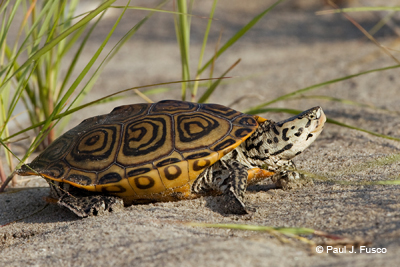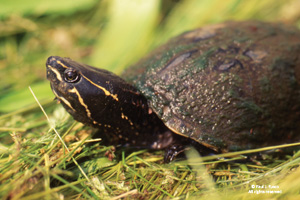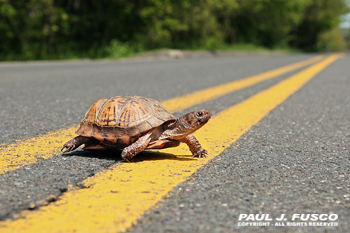Turtles of Connecticut
NEW Book Available for Purchase! Conservation of Amphibians and Reptiles in Connecticut -- This 305-page, detailed text includes 131 color photos, species account maps, and conservation solutions for the complex challenges faced by Connecticut’s amphibians and reptiles. Learn more!
How Many Turtle Species Are There?
Currently, 328 species of turtles are known worldwide; 57 (20% of the world's turtle species) are found in the United States and Canada. The United States has more native turtle species than any other country -- it is a turtle biodiversity hotspot.
Twelve turtle species (including 4 sea turtles) occur in Connecticut. Nine of these turtles are currently on the state's List of Endangered, Threatened and Special Concern Species.
Connecticut’s Native Turtle Species
Bog Turtle
Common Musk Turtle
Common Snapping Turtle
Eastern Box Turtle
Northern Diamondback Terrapin
Eastern Painted Turtle
Spotted Turtle
Wood Turtle
Atlantic Green Sea Turtle
Atlantic Ridley Sea Turtle
Leatherback Sea Turtle
Loggerhead Sea Turtle
Featured Turtles
Northern Diamondback Terrapin
(Malaclemys terrapin)
Diamondback terrapins are the only Connecticut turtles that live in the brackish water of salt marshes, estuaries, and tidal creeks. These turtles cannot be collected or possessed in Connecticut.
To learn more, visit:
Northern Diamondback Terrapin Fact Sheet
U.S. Fish and Wildlife Service Northeast Region
Common Snapping Turtle
Frequently Asked Questions about Snapping Turtles
Sea Turtles
Have you ever wondered if there are sea turtles in Long Island Sound? Although these marine creatures are better known for nesting in the tropics, sea turtles frequent the waters of the northeastern United States. Of the eight species of sea turtles in the world, four have been documented in Connecticut waters in Long Island Sound. (learn more)
A Closer Look at Turtles
Turtles are in trouble. The International Union for the Conservation of Nature (IUCN), an organization that maintains a comprehensive list (Red List) of the status of the world's species, categorizes 47% of all living turtle species as threatened.
Threats to U.S. Turtles
Humans cause the largest harm to turtle populations, but we have the power to make positive changes toward turtle survival. The largest threats to turtle populations include:
- Habitat loss and degradation;
- Over-harvest of wild turtles for food, traditional medicines, and pets;
- Illegal trafficking of wild turtles;
- Mortality from roads, agricultural machinery, fishing by-catch, and predators;
- Exotic invasive species and diseases;
- Loss of unique genetic make-up due to hybridization; and
- Climate change.
Conservation Action Can Help
Careful stewardship and conservation action can successfully slow or reduce the declining trend of turtles. Because turtles can respond well to population management and conservation, it is not too late to preserve our turtle heritage. Three basic approaches for species conservation include:
- Protecting rare species and their habitats;
- Managing common turtle species and their habitats so that they remain common; and
- Managing crisis situations, such as species in peril from acute hazards, like oil spills.
What You Can Do to Help Turtles

- Leave turtles in the wild. They should never be kept as pets. Whether collected singly or for the pet trade, turtles that are removed from the wild are no longer able to be a reproducing member of a population. Every turtle removed reduces the ability of the population to maintain itself.
- Never release a captive turtle into the wild. It probably would not survive, may not be native to the area, and could introduce diseases to wild populations.
- Do not disturb nesting turtles. During May through July, turtles look for soft, sandy soil to dig a nest for their eggs. After the female leaves, the eggs develop unattended over the course of the summer and hatchling turtles emerge in the early fall. If you see a turtle laying eggs, leave her alone and give her the time and space to finish. If the nest is in a high traffic area, a strategically placed obstacle (stake with flagging, traffic cone, lawn chair, etc.) is a good way of making sure that the nest does not get stepped on. If you are concerned about predators, an overturned laundry basket or milk crate with a rock on top works well to protect the nest hole until the scent dissipates and the ground settles around the eggs. Do not keep this covering on for very long – shading can change the nest temperature and impact the development of the eggs.
- As you drive, watch out for turtles crossing the road. Turtles found crossing roads in June and July are often pregnant females and they should be helped on their way and not collected. Without creating a traffic hazard or compromising safety, drivers are encouraged to avoid running over turtles that are crossing roads. Also, still keeping safety precautions in mind, you may elect to pick up turtles from the road and move them onto the side they are headed. Never relocate a turtle to another area that is far from where you found it. (More details)
- Help combat illegal wildlife trade, which often involves turtles.
- Make your backyard a better habitat for reptiles and amphibians. The Northeast Partners in Amphibian and Reptile Conservation has developed an educational brochure entitled "Your Backyard Guide: Helping Amphibians and Reptiles" to get you started on creating better wildlife habitat in your yard.
- Learn more about turtles and educate others.
Turtles and Roads Are a Deadly Combination
The months of May through July are the nesting season for many turtles. At this time, egg-bearing females sometimes travel great distances to find the perfect location to dig a nest and lay eggs. Aquatic turtles also leave the water to travel across land in search of terrestrial nesting sites. Connecticut’s landscape is highly fragmented by busy roads, and many turtles are forced to travel great distances – and across roadways – to find suitable nesting habitat. Helping a turtle move across the road can be the difference between life and death for the animal, and for future generations, BUT YOUR SAFETY COMES FIRST. Be sure to assist a turtle in the road only when it is safe to do so and do not attempt to stop traffic.
Research has shown that aquatic turtle populations across the United States have uncommonly high proportions of males because so many female turtles are being killed on roadways.
Guidance on Assisting Turtles: Always keep the turtle pointed in the direction it is going. If you turn it around in the other direction, the turtle will only make another attempt to cross the road. Also, DO NOT move the turtle to a “better spot,” and DO NOT put terrestrial box turtles in a lake, pond, or other water body. Turtles have a home range and females often return to the same general area to lay their eggs. Snapping turtles can be large, heavy, and feisty, so if you are unable to “shoo” them across the road, pick them up by the back of their shells, NOT by their tail, to avoid a bite. Some people use a shovel or a stick to push or skid snapping turtles across the road.
Turtles have a long lifespan, take a long time to reach sexual maturity, and have low survivorship when newly hatched. Because of these attributes, turtle populations cannot compensate for losses due to adult mortality without experiencing long-term consequences. With turtle populations requiring high levels of adult survivorship, every individual is important to a population’s stability. This concern is even greater in recent years because many U.S. turtle populations are becoming fragmented, isolated, and progressively smaller.
In your travels, if you encounter a turtle in the road, just remember this motto: “If it is safe, help turtles cross the road.”
Content last updated in November 2022.

